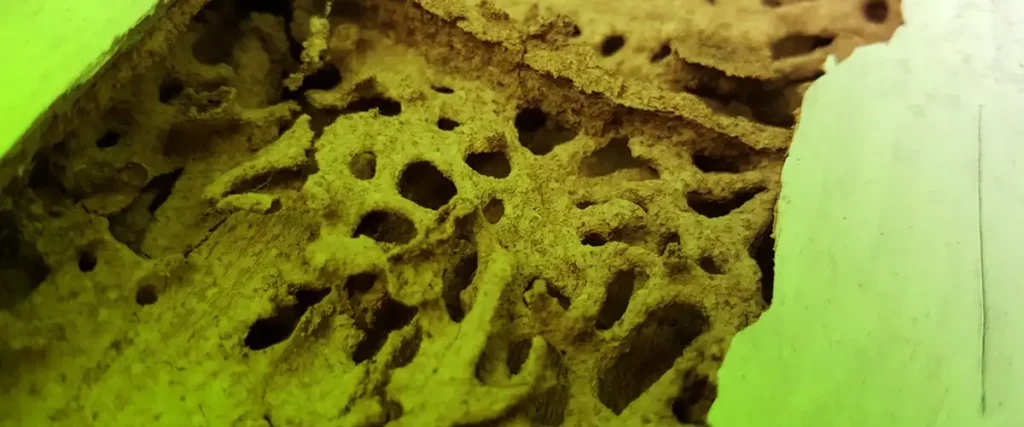Did you know that termites can silently destroy your home, causing significant damage and headaches? We have the perfect solution if you’re worried about protecting your property from these pests! Protect your home with these simple and cost-effective solutions. Termite treatments play a crucial role in preventing structural damage to homes. Early intervention in termite infestations allows homeowners to avoid expensive repairs in the future.
Furthermore, DIY termite treatments offer an attractive solution, saving time and money and providing convenience. Implementing these treatments allows homeowners to take proactive measures against termites, effectively eliminating infestations and avoiding the headache-inducing consequences. This guide will explore five DIY termite treatments that can provide effective results while saving you time, money, and headaches.

Identifying Termite Infestations
Early detection is crucial in preventing extensive termite damage. Therefore, it is essential to know the common signs of termite infestations, such as:
- Mud tubes on walls or foundations
- Discarded wings near windows, doors, or light sources
- Wood that sounds hollow when tapped
In addition, early detection is vital in taking prompt action and minimizing the damage caused by termites. Before applying DIY termite treatments, conducting a comprehensive inspection of your property is crucial.
Now, let’s delve into some effective DIY termite treatments—the following are the solutions you’ve been looking for:

1. Cardboard Trap Method
One practical and cost-friendly DIY termite treatment is the cardboard trap method. Termites are highly attracted to cellulose, which is abundant in cardboard.
To use cardboard traps, follow these steps:
- Cut corrugated cardboard into small pieces.
- Wet the cardboard to create a damp environment.
- Place the cardboard near suspected termite activity.
- Check the traps regularly.
- When termites infest the cardboard, remove and destroy it.
While the cardboard trap method can eliminate a small termite colony, it may not completely eradicate a large infestation and require additional treatments.

2. Orange Oil Treatment
Orange oil is an excellent option for eco-friendly DIY termite treatment. It extracted from orange peels proves lethal to termites upon contact. Here’s the application process:
- Drill small holes in termite-infested wood.
- Inject orange oil into the holes.
- Seal the holes. The oil will spread, targeting termites in the vicinity.
Orange oil treatment is particularly effective for localized infestations, as it targets the termites directly. However, it is crucial to handle and apply orange oil with caution; ingesting or coming into contact with the skin can be harmful.

3. Borax Solution Treatment
Borax, a natural mineral, is effective in killing termites. It’s both cost-effective and safe for humans and pets. To use borax solution for termite treatment, follow these steps:
- Mix borax with warm water.
- Apply the solution to termite-affected wood.
- When termites come into contact with this solution, it leads to their demise.
Borax solution treatment is effective, primarily when used preventatively. However, it may require regular reapplication, as the solution can break down over time. Additionally, borax may be less effective when dealing with large, established termite colonies.

4. Diatomaceous Earth Treatment
Diatomaceous earth is an excellent option if you prefer a non-toxic DIY termite treatment. It is a natural product that effectively kills termites by dehydrating them.
To apply diatomaceous earth for termite treatment, follow these steps:
- Sprinkle a generous layer near termite-infested areas such as the soil or wooden structures.
- Ensure that the treatment covers the places where termites are active.
- As termites come into contact with the powder, their exoskeletons are damaged, leading to dehydration and death.
Remember to wear a mask and gloves during application, as inhaling the dust may be harmful. However, diatomaceous earth may not eliminate large colonies or reach hidden infestations. It may also be necessary to reapply the powder after rain or when it becomes moist.

5. Nematodes Treatment
Microscopic organisms known as beneficial nematodes can serve as natural enemies to termites. To use nematodes for termite treatment, follow these instructions:
- Nematodes are applied to the soil, actively seeking out termite colonies and infecting them.
- Water the soil around termite colonies to create favorable conditions for nematodes.
- Once inside the termites, the nematodes release bacteria that kill the termites from the inside out.
Furthermore, this environmentally friendly treatment method can effectively target termite populations. However, following the instructions when applying nematodes is crucial, as they require specific moisture conditions to survive. Additionally, nematodes may not be suitable for treating sandy or arid soil infestations.

Prevention and Monitoring
While DIY termite treatments, such as New Jersey’s termite treatments, can effectively deal with infestations, prevention is always the best approach. Additionally, by taking specific preventive measures, homeowners can reduce the risk of future termite infestations. To avoid future infestations, follow these tips:
- Reduce Moisture – Termites thrive in damp conditions. Ensure your property is well-ventilated and dry.
- Eliminate Food Sources – Removing termite food sources like firewood or excess vegetation can deter termites.
Moreover, regular monitoring of the inside and outside property can help identify early signs of termite activity. Taking swift action at the first sign of an infestation can prevent extensive damage and the need for costly professional treatments.

No More Termites, DIY-style!
Finally, termite treatments are vital for protecting properties from structural damage. Implementing DIY termite treatments can be cost-effective and time-saving for small infestations. However, professional assistance is advisable for severe infestations or property-specific treatment plans.
Furthermore, property owners can safeguard their investments from the destructive effects of termites by reinforcing the importance of termite treatments and encouraging proactive measures. Regular inspections, preventive measures, and timely interventions are vital in maintaining a termite-free environment.
References:
- Potter, M. F. (n.d.). Protecting your Home Against Termites. | Entomology. Retrieved from https://entomology.ca.uky.edu/ef605
- Matt. (2022, December 24). Saving Time And Money: DIY Tips For Treating And Preventing Termites In Your Home | Mast Producing Trees. Retrieved from https://mast-producing-trees.org/saving-time-and-money-diy-tips-for-treating-and-preventing-termites-in-your-home/
- Lutz, A. (2023, November 6). How to get rid of termites. Retrieved from https://www.architecturaldigest.com/reviews/pest-control/how-to-get-rid-of-termites







